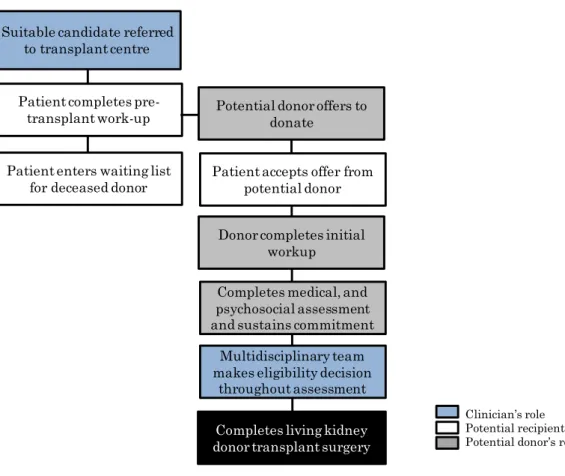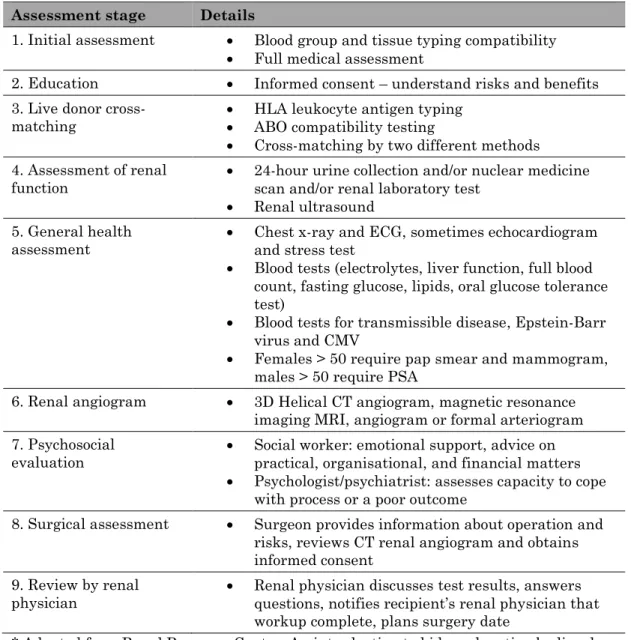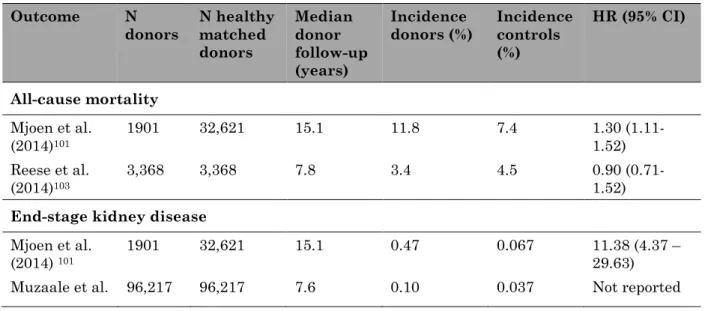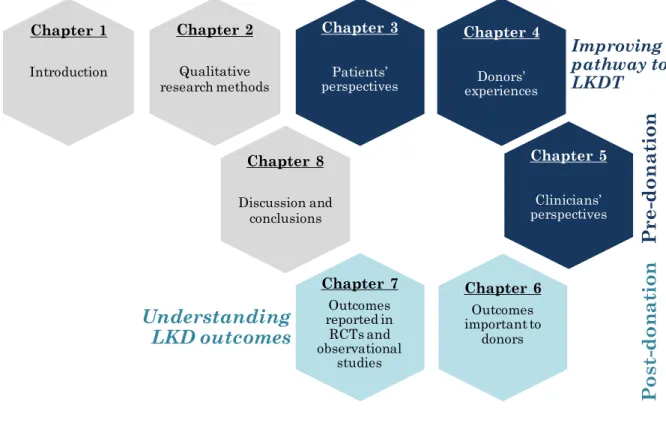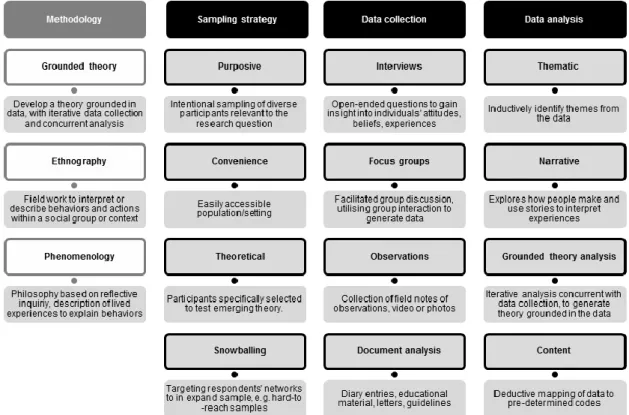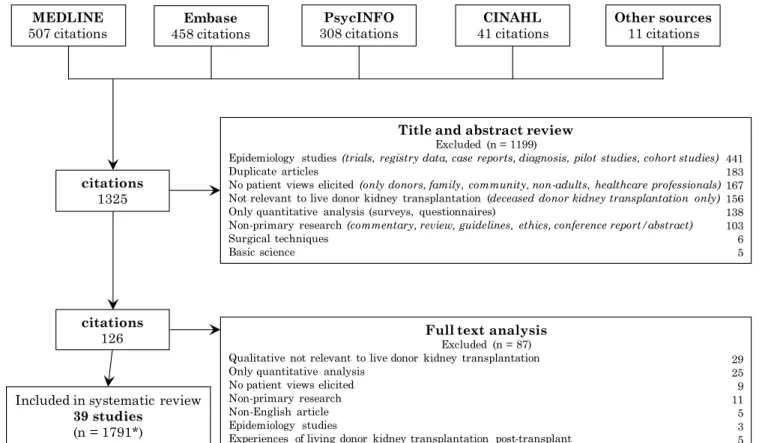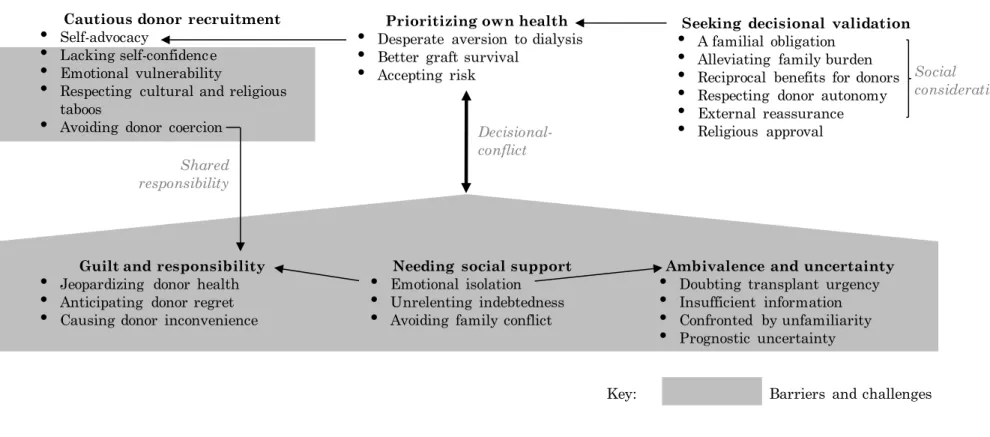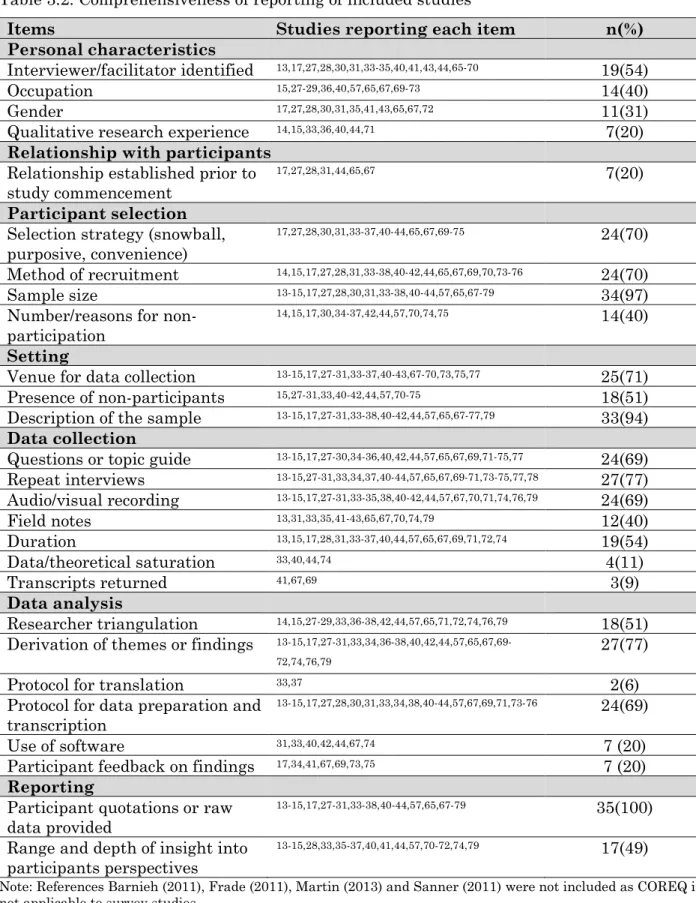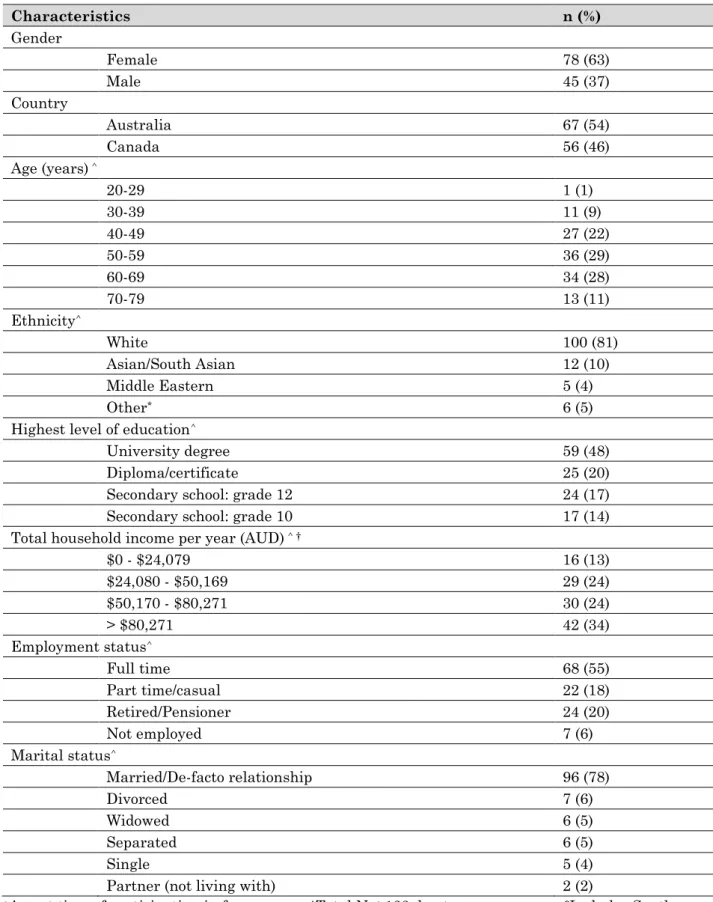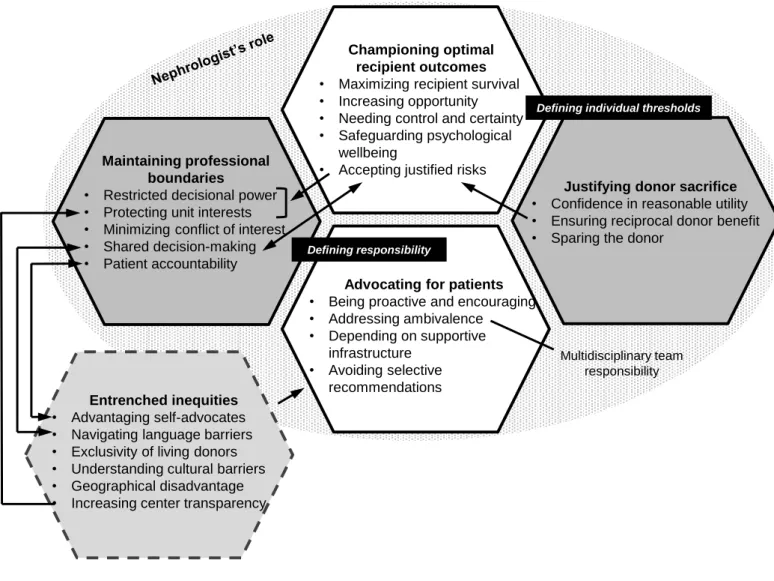Improving Access and Outcomes in Living
Kidney Donor Transplantation
Camilla Sara Hanson
A thesis submitted in fulfilment of the requirements for the degree of Doctor of Philosophy
Sydney School of Public Health Sydney Medical School The University of Sydney
ii
Declaration
This is to certify that to the best of my knowledge, the content of this thesis is my own work. This thesis has not been submitted for any degree or other purposes.
I certify that the intellectual content of this thesis is the product of my own work and that all the assistance received in preparing this thesis and sources has been acknowledged.
Signature: ………. Date: ………... Camilla Sara Hanson
iii
Author’s Contribution
The work presented in this thesis has been carried out by the author under the supervision of Associate Professor Allison Tong and Professor Jonathan Craig of the Sydney School of Public Health, The University of Sydney.
The author planned the research, designed the studies, obtained ethics approval, collected, managed and analysed the data, interpreted results, drafted and revised the manuscripts for submission to peer-reviewed journals, and wrote and compiled this thesis.
As supervisor for the candidature upon which this thesis is based, I can confirm that the authorship attribution statements above are correct. Signature: ………. Date: ………... A/Professor Allison Tong
iv
Ethical Clearance
The study presented in Chapter 4 was approved by the Human Research Ethics Committee at the University of Sydney.
The studies presented in Chapters 4 and 6 were approved by the Western Sydney Local Health District Human Research Ethics Committee, Monash Health Ethics Committee, and the University of British Columbia and Providence Health Care Research Ethics Board.
All participants gave written informed consent for participation in the study.
v
Abstract
Shortages in deceased organ donation have necessitated widespread acceptance of living donor kidney transplantation, which offers better outcomes in terms of graft survival, life expectancy and quality of life for many patients with end-stage kidney disease, compared with deceased donor kidney transplantation and dialysis. However, there are barriers and challenges that exist in the current practice of living kidney donor transplantation. Overall, the rates of living kidney donor transplantation have decreased or plateaued, with ethical and socio-economic disparities in access to living kidney donation reported in many countries, that remain largely unexplained. Living donors must accept risks associated with undergoing nephrectomy, despite the evidence on the long-term risks of living kidney donation remaining uncertain. In response, there have been efforts to identify and describe the barriers and disparities in living kidney donor transplantation, and to assess a range of outcomes for living donors. Yet, little is known about the donors’ priorities for outcomes. A comprehensive understanding of the values, beliefs, experiences, priorities and preferences of the key stakeholders, including donors and health professionals involved in their care, is needed to ensure that research, clinical practice and policy in living kidney donations address their needs and priorities.
The first part of this thesis (Chapters 3 to 6) consists of qualitative studies that describe in-depth the perspectives and experiences of kidney
transplant recipients, living kidney donors and nephrologists. These studies address recipient decision-making, donors’ experiences of the evaluation process, and nephrologists’ perspectives on recipient eligibility and disparities in living kidney donor transplantation.
vi
Chapter 2 provides an overview of qualitative health research methods and principles including participant selection, data collection and analysis. The approaches used to demonstrate rigour are discussed in terms of credibility, confirmability, dependability and transferability.
In Chapter 3, to understand recipient expectations and attitudes
regarding living kidney donor transplantation, a systematic review and thematic synthesis of primary qualitative studies that examined recipient perspectives was conducted. Six themes were identified, including
prioritising own health, guilt and responsibility, ambivalence and uncertainty, seeking decisional validation, needing social support, and cautious donor recruitment. A new conceptual schema of the barriers and facilitators was developed, highlighting the need to address patients’ concerns regarding donor outcomes, guilt, relationship tensions and donor recruitment.
Chapter 4 examines how donors sustain commitment to donation during the evaluation period, including their experiences with informed consent, and their medical and psychosocial assessment. From focus groups
conducted in Australia and Canada, themes were identified that reflected the challenges they experienced, including underlying fears for their health, obstructive system shortfalls and lifestyle interference. Their emotional investment, feeling undeterred by low risks, and mental preparation for possible donation outcomes sustained their commitment throughout the evaluation process, despite facing these challenges. Chapter 5 describes nephrologists’ attitudes towards recipient eligibility and access to living kidney donor transplantation. Nephrologists from Australia and New Zealand participated in a semi-structured interview study. The themes identified reflected nephrologists’ competing priorities - to achieve optimal recipient outcomes, ensure the risk to the donor was justified, and to protect their transplant unit’s integrity. Nephrologists also considered disparities to be entrenched and difficult to address within
vii
their roles and limited resources. This analysis led to recommendations to promote more equitable decision-making and help nephrologists address disparities and advocate for disadvantaged patients.
The second part of this thesis (Chapters 6 and 7) is focussed on outcomes for living kidney donors. These studies sought to identify the outcomes most important to donors and evaluate the spectrum and consistency of outcomes reported in trials and observational studies of living kidney donors.
In Chapter 6, outcomes most important to living kidney donors and the reasons for their choices were elicited using nominal group technique – a mixed methods approach that incorporates quantitative ranking and qualitative focus group discussion. The top five most important outcomes included kidney function, time to recovery, surgical complications, donor-recipient relationship and lifestyle restrictions. The themes that explained their rankings included unfulfilled expectations, heightened susceptibility, confidence and empowerment, downplaying risks and harms, and
worthwhile sacrifice.
Chapter 7 presents the scope and frequency of outcomes reported in recent trials, and observational studies in living kidney donors based on a
systematic review. The top five most frequently reported domains were kidney function, time to discharge, blood loss/transfusion, operative time and blood pressure. There was also large heterogeneity in the measures used to assess the same outcomes.
The latter two chapters highlight a mismatch between outcomes that were most frequently reported in contemporary studies in living kidney donors and outcomes explicitly identified to be most important to donors, such as time to recovery, clinical outcomes including pain and mortality, and psychosocial outcomes including the donor-recipient relationship, lifestyle restrictions, life satisfaction and family life.
viii
In conclusion, this thesis identifies potential strategies to address the tensions and challenges in the pathway to living kidney donor
transplantation for recipients, donors and nephrologists. The findings highlight the need for culturally sensitive, family-oriented educational and psychosocial support to resolve recipient ambivalence, and help patients find an acceptable approach to engaging in discussions with potential donors. They also highlight the need to help nephrologists to better advocate for their patients. To facilitate equitable decision-making, and resolve tensions and uncertainties for nephrologists, it was demonstrated that there is a need for greater consensus and standardized practice regarding complex medical psychosocial cases, and greater transparency of centre practices. Focus groups with living donors showed that more attention is needed to the psychosocial challenges of live donor evaluation; including preparing donors for surgery and recovery, minimising anxiety and lifestyle burdens, ensuring donors feel comfortable expressing their fears and concerns, and making explicit the responsibilities of donors in their assessment process.
This thesis also provides greater understanding of the outcomes that are most important to donors, and a framework for improving the relevance of outcomes reported in trials and observational studies to clinical and donor decision-making. It was demonstrated that consistent reporting of
outcomes relevant to decision making is needed to better inform and prepare donors for outcomes after donation. Overall, the acknowledgement
of stakeholder perspectives in guidelines, education, research and practice needs to address the real tensions faced by nephrologists, recipients and donors, to ensure equitable decision-making, alleviate barriers and disparities, and improve outcomes for recipients and their donors.
ix
Acknowledgements
There have been many people involved in my doctoral candidature whom I would like to thank. First, I am grateful for the support, guidance and encouragement from my supervisors, Associate Professor Allison Tong and Professor Jonathan Craig. Allison’s passion for patient-centred research, her expertise in qualitative methods, her drive and optimism are
infectious, and stimulated my growing interest in research. I am grateful for Jonathan’s expert guidance, his wisdom and his challenge to me to think more deeply and more broadly. I thank them both for creating many opportunities for me to attend and present my work at both national and international conferences. Their generosity with their time and their willingness to teach have ensured that my PhD candidature has been a valuable and enjoyable period.
I thank Armando Teixeira-Pinto for providing her statistics expertise to improve the analysis of the nominal group study.
The wonderful colleagues and friends at the Centre for Kidney Research have made my four years of study a particularly happy and enjoyable time. I regard myself as very fortunate to have found my way to such a sociable and collaborative work environment.
I would like to acknowledge the role of the nephrologists, nurses and researchers who helped to coordinate the donor focus group study at Monash Medical Centre, Westmead Hospital and St Paul’s Hospital. I am inspired by the dedication and hard work that they put into caring for their donors and transplant patients, and their interest in receiving feedback from their donors to continuously improve the care they give their patients.
x
I would also like to acknowledge the donors who participated in our focus group study. I am grateful that they took the time to attend our focus group, and share their experiences of donating a kidney.
I thank my family and friends, particularly Mum, Dad, Guy and Tim for their endless support and encouragement. Thank you for keeping me company while I finished off the last few papers, cooking my meals, and providing the captive audience to hear my talks and the motivation to hurry up and get the thesis done.
I would like to dedicate this thesis to my paternal grandmother, Anita Hanson, whom I never met. She died of renal failure in 1954 – the year of the first living kidney donor transplant.
xi
Table of Contents
Declaration ii
Author’s Contribution iii
Ethical Clearance iv
Abstract v
Acknowledgements ix
Table of Contents xi
List of Figures xvi
List of Tables xvii
First author publications arising from this thesis xviii Conference proceedings arising from this thesis xx First author awards arising from this thesis xxii
List of abbreviations xxiii
Chapter 1: Introduction
1.1 Overview 1
1.2 Living kidney donor transplantation 1
1.3 Ethical considerations 3
1.4 The living kidney donor transplant pathway 4 1.5 Barriers and disparities in living kidney donor
transplantation
9
1.6 Outcomes of living kidney donation 15
1.7 Justification for the study 20
1.8 Qualitative research methods used in the study 21
1.9 Aims of the research 24
1.10 Structure of the thesis 25
1.11 References 27
xii
Chapter 2: Qualitative research: methods and rigour
2.1 Introduction 41
2.2 Participant selection and recruitment 41
2.3 Data collection 42
2.4 Data analysis 42
2.5 Appraising qualitative research 43
2.6 Conclusion 45
2.7 References 46
Chapter 3: The expectations and attitudes of patients with chronic kidney disease towards living kidney donor transplantation: a thematic synthesis of qualitative studies 3.1 Abstract 49 3.2 Introduction 50 3.3 Methods 50 3.4 Results 52 3.5 Discussion 58 3.6 References 72
Chapter 4: The lived experience of ‘being evaluated’ for organ donation: focus groups with living kidney donors
4.1 Abstract 80 4.2 Introduction 81 4.3 Methods 81 4.4 Results 83 4.5 Discussion 88 4.6 Acknowledgements 92 4.7 References 99
xiii
Chapter 5: Nephrologists’ perspectives on recipient eligibility and access to living kidney donor transplantation
5.1 Abstract 103 5.2 Introduction 104 5.3 Methods 105 5.4 Results 107 5.5 Discussion 115 5.6 Acknowledgements 119 5.7 References 127
Chapter 6: Identifying outcomes that are important to living kidney donors: a nominal group technique
6.1 Abstract 133 6.2 Introduction 134 6.3 Methods 135 6.4 Results 138 6.5 Discussion 143 6.6 Acknowledgments 148 6.7 References 157
Chapter 7: Living kidney donor outcomes reported in randomized trials and observational studies
7.1 Abstract 162 7.2 Introduction 163 7.3 Methods 164 7.4 Results 166 7.5 Discussion 168 7.6 References 178
Chapter 8: Discussion and conclusions
8.1 Summary of findings 182
xiv
8.3 Comparison with other studies 193
8.4 Implications for clinical practice and policy 198
8.5 Implications for research 206
8.6 Conclusion 209
8.7 References 210
Appendix A: Supporting data for Chapter 3
A.1 Search strategy 216
Appendix B: Supporting data for Chapter 4
B.1 Focus group question guide 218
Appendix C: Supporting data for Chapter 5
C.1 Interview guide 219
Appendix D: Supporting data for Chapter 6
D.1 Individual ranking of all outcomes 220 D.2 Location and number of participants in each nominal
group
221
D.3 Focus group run sheet 222
Appendix E: Supporting data for Chapter 7
E.1 Search results 224
E.2 Frequency of outcome measures among trials reporting mortality
225
E.3 Frequency of outcome measures among trials reporting cardiovascular event
226
E.4 Frequency of outcome measures among trials reporting ESKD
227
E.5 Frequency of outcome measures among trials reporting kidney function
228
E.6 Frequency of outcome measures among trials reporting blood pressure
229
E.7 Frequency of outcome measures among trials reporting proteinuria/albuminuria
xv
E.8 Frequency of outcome measures among trials reporting pain
231
E.9 Frequency of outcome measures among trials reporting physical function
232
E.10 Frequency of outcome measures among trials reporting psychological impact
233
E.11 Search strategy 234
E.12 Proportion of studies reporting each clinical outcome 235 E.13 Proportion of studies reporting each surrogate outcome 237 E.14 Proportion of studies reporting each donor-reported
outcome
238
E.15 Frequency of all outcome domains reported in therapy studies
239
E.16 Frequency of all outcome domains reported in prognosis studies
xvi
List of Figures
Figure 1.1 Key steps in the pathway to living kidney donor transplantation
5
Figure 1.2 Thesis chapter outline 27
Figure 2.1 An outline of common methodologies and methods used in qualitative research
43
Figure 3.1 Search results 63
Figure 3.2 Thematic schema 64
Figure 4.1 Thematic schema 93
Figure 5.1 Thematic schema 120
Figure 6.1 Importance scores for donor outcomes by country 149
Figure 6.2 Thematic schema depicting themes underpinning ranking of outcomes
150
Figure 7.1 Proportion of therapy studies reporting each outcome domain
173
Figure 7.2 Proportion of prognosis studies reporting each outcome domain
174
Figure 7.3 Number of outcome measures for selected outcome domains among studies
175
xvii
List of Tables
Table 1.1 Living kidney donor evaluation and education 6
Table 1.2 Summary of recent evidence on living kidney donor outcomes
17
Table 3.1 Characteristics of included studies (grouped by country) 65
Table 3.2 Comprehensiveness of reporting of included studies 67
Table 3.3 Illustrative quotations 68
Table 4.1 Demographic characteristics of the participants 94
Table 4.2 Donation characteristics 95
Table 4.3 Illustrative quotations 96
Table 5.1 Participant characteristics 121
Table 5.2 Illustrative quotations 122
Table 5.3 Implications for practice and policy to address barriers and inequity
126
Table 6.1 Demographic characteristics of the participants 151
Table 6.2 Donation and health characteristics of the participants 152
Table 6.3 Illustrative quotations 153
Table 7.1 Characteristics of included studies 176
xviii
First Author Publications Arising from
this Thesis
This thesis is presented for examination as a thesis containing published work. Chapters 2, 3 4, and 5 have been published in international peer-reviewed journals, Chapter 6 is under revision, and Chapter 7 has been submitted for publication. The candidate is the first and corresponding author of each of these papers.
Chapter 2 Hanson CS, Craig CC, Tong A. In their own words:
the value of qualitative research to improve the care of children with chronic kidney disease”. Pediatric
Nephrology 2016; 1-7. (October 15th 2016, PMID: 27744620
DOI10.1007/s00467-016-3526-y
Chapter 3 Hanson CS, Chadban SJ, Chapman JR, Craig JC, Wong
G, Ralph AF, Tong A. The expectations and attitudes of patients with CKD towards living kidney donor
transplantation: a thematic synthesis of qualitative studies. Transplantation 2015; 99 (3): 540-544. (December 2nd 2014, PMID: 25463967 DOI:
10.1097/TP.0000000000000433
Chapter 4 Hanson CS, Ralph AF, Manera KE, Gill JS, Kanellis J,
Wong G, Craig JC, Chapman JR, Tong A. The lived experience of ‘being evaluated’ for organ donation: focus groups with living kidney donors. Clinical Journal American Society of Nephrology (In press, accepted July 17th 2017)
Chapter 5 Hanson CS, Chadban SJ, Chapman JR, Craig JC, Wong
G, Tong A.Nephrologists' perspectives on patient eligibility and access to living donor kidney
transplantation. Transplantation 2014; 199 (4): 943-953. (Accepted 3rd May 2015, PMID: 26425873, DOI:
10.1097/TP.0000000000000921).
xix
Craig JC, Teixeira-Pinto A, Chadban SJ, Garg AX, Ralph AF, Pinter J, Lewis JR, Tong A. Identifying outcomes that are important to living kidney donors: a nominal group technique study. (Submitted, August 2017)
Chapter 7 Hanson CS, Sautenet B, Craig JC, Chapman JR, Knoll G,
Reese, PP, Tong A. Informative for decision-making? The spectrum and consistency of outcomes following living kidney donation reported in trials and observational studies. (Submitted, August 2017)
xx
Conference Proceedings Arising from
this Thesis
Hanson CS, Chadban S, Chapman JR, Wong G, Craig JC, Tong A. Patients’ attitudes towards living kidney donation: systematic review and thematic synthesis of qualitative research. Australian and New Zealand Society of Nephrology 29th Annual Scientific Meeting, 9-11 September 2013, Brisbane, Australia.
Hanson CS, Chadban SJ, Chapman JR, Wong G, Craig JC, Tong A. Patients' attitudes towards living kidney donation: systematic review and thematic synthesis of qualitative research. 12th Congress of the International Society for Organ Donation and Procurement, 21-24 November 2013, Sydney, Australia.
Hanson CS, Chadban SJ, Chapman JR, Craig JC, Wong G, Ralph AF, Tong A. Patients' attitudes towards living kidney donation: systematic review and thematic synthesis of qualitative research. The Transplantation Society of Australia and New Zealand 32nd Annual Scientific Meeting, 11-13 June 2014, Canberra, Australia.
Hanson CS, Chadban SJ, Chapman JR, Craig JC, Wong G, Tong A. Everyone's got their own threshold. Nephrologists' perspectives on patient eligibility and access to living donor kidney transplantation. World Transplant Congress, 26-31 July 2014, San Francisco, United States.
Hanson CS, Chadban SJ, Chapman JR, Craig JC, Wong G, Ralph A, Tong A. Patients' attitudes towards living kidney donation: systematic review and thematic synthesis of qualitative research. World Transplant Congress, 26-31 July 2014, San Francisco, United States.
Hanson CS, Chadban SJ, Chapman JR, Craig JC, Wong G, Tong A. "Everyone's got their own threshold". Nephrologists' perspectives on patient eligibility and access to living kidney donor transplantation. Australian and New Zealand
xxi
Society of Nephrology 50th Annual Scientific Meeting, 25-27 August 2014, Melbourne, Australia.
Hanson CS, Chadban SJ, Chapman JR, Craig JC, Wong G, Tong A. "Everyone's got their own threshold". Nephrologists' perspectives on patient eligibility and access to living kidney donor transplantation. 13th Congress of the International Society of Organ Tissue and Donation, 17-20 October 2015, Seoul, Korea.
Hanson CS, Kanellis J, Chadban SJ, Chapman JR, Craig JC, Wong G, Pinter J, Garg AX, Gill JS, Lewis JR, Tong A. Living Kidney Donor Priorities for
Outcomes: A Nominal Group Technique Study. 34th Annual Scientific Meeting of the Transplant Society of Australia and New Zealand, April 10-12, 2016, Sydney, Australia.
Hanson CS, Kanellis J, Chadban SJ, Chapman JR, Craig JC, Wong G, Pinter J, Garg AX, Gill JS, Lewis JR, Tong A. Living Kidney Donor Priorities for
Outcomes: A Nominal Group Technique Study. The 4th Ethical, Legal and Psychosocial Aspects of Organ Transplantation Congress, April 22-25, 2016, Rome, Italy.
Hanson CS, Kanellis J, Chadban SJ, Chapman JR, Craig JC, Wong G, Pinter J, Garg AX, Gill JS, Lewis JR, Tong A. Living Kidney Donor Priorities for
Outcomes: A Nominal Group Technique Study. 2016 American Transplant Congress, June 11-15, 2016, Boston, United States.
Hanson CS, Kanellis J, Chadban SJ, Chapman JR, Craig JC, Wong G, Pinter J, Garg AX, Gill JS, Lewis JR, Tong A. Living Kidney Donor Priorities for
Outcomes: A Nominal Group Technique Study. The 26th International Congress
xxii
First Author Awards Arising from
this Thesis
Kidney Health Australia Medical Research Scholarship (June 2013-January 2015)
National Health and Medical Research Postgraduate Scholarship (January 2015-January 2017)
Young Investigator Award, The Transplantation Society of Australia and New Zealand, 2014
Travel grant to attend the Australian and New Zealand Society of Nephrology Annual Scientific Meeting in Melbourne, Victoria, 2014
Travel grant to attend the Australian and New Zealand Society of Nephrology Annual Scientific Meeting in Melbourne, Victoria, 2014
Travel grant from the Transplant Society of Australia and New Zealand to attend the Transplant Society International Congress in Hong Kong, 2016
Travel grant from the Transplant Society of Australia and New Zealand to attend the 13th Congress of the International Society of Organ Donation and
Procurement, Seoul, 2016
The Transplant Society International Society of Organ Donation and Transplantation Scientific Award, June 2017
Westmead Association Research Travel Grant to attend the 14th Congress of the
xxiii
List of Abbreviations
CINAHL Cumulative Index for Nursing and Allied Health Literature
COREQ Consolidated Criteria for Reporting Qualitative Health Research
CKD Chronic Kidney Disease
ENTREQ Enhancing Transparency for Reporting Qualitative Health Research
ESKD End-Stage Kidney Disease
GFR Glomerular Filtration Rate HDI Human Development Index
KDIGO Kidney Disease Improving Global Outcomes
LKDT Living Kidney Donor Transplantation MeSH Medical Subject Headings
NGT Nominal Group Technique
OMERACT Outcomes Measures in Rheumatology OPTN Organ Procurement Transplant Network
QOL Quality of Life
RELIVE Renal and Lung Living Donors Evaluation
1
Chapter 1: Introduction 1.1 Overview
“A rising demand for organs exists without enough organs to meet it, making the urgency for those willing and able to donate even more critical and the need for innovation and support even more imperative.”
- Barak Obama, April 1st 2016
This thesis is presented as a series of papers that address the overall aim of improving access and outcomes in living kidney donor transplantation. In this chapter, background literature is reviewed to provide an overview of living kidney donor transplantation. This is followed by a discussion of important gaps in research and practice in addressing barriers and disparities in living kidney donor transplantation, and ways to improve the donation pathway and outcomes for living kidney donors. This chapter also includes justification for this research, the value of qualitative
research methods, and an outline of the aims of each study.
1.2 Living kidney donor transplantation
The first successful living kidney donor transplantation was performed in 1954 in Boston Massachusetts, between identical twin brothers. Living kidney donor transplantation is now the preferred treatment option for many patients with end-stage kidney disease, as it is associated with superior graft survival, patient survival and quality of life outcomes.1,2
Moreover, the unresolved shortages in deceased organ donation have necessitated widespread acceptance of living kidney donor
transplantation.3 In 2014, 23,233 transplants were made available by
living kidney donors, comprising 42% of all kidney transplants worldwide.4
2
The rate of living kidney donor transplantation varies widely across countries, and differences in transplant policy and practice are apparent.5
In high income countries, including Australia, Canada, the United Kingdom and the United States, living kidney donor transplantation comprises up to 40% of kidney transplants.6 Spain’s highly successful
deceased donor program has resulted in a very low proportion of living kidney donors, at less than 10%.7 In contrast, living donors comprise 90%
of all kidney transplantations in Japan, due to legal restrictions on deceased donation (which were revised in 2010).3 In Saudi Arabia, high
rates of living donation are thought to be related to a large uptake of unrelated donors.3 In Hong Kong and Taiwan, emotionally related
donation is restricted. Furthermore, living unrelated donation is prohibited in many countries in Asia.8
Reimbursement practices for donors differ substantially, ranging from the provision of paid leave (e.g. Australia), reimbursement for out-of-pocket expenses (e.g. Canada) and government regulated compensation in Iran.9
In most countries, payment for donation is illegal10, although organ
trafficking and transplant tourism are still practised11.
Major innovations in transplantation have transformed and improved access and outcomes in living kidney donor transplantation for both patients and donors. Advances in immunosuppression and recipient desensitization techniques have enabled unrelated donors, who are blood-type or human leukocyte antigen incompatible, to donate.12,13 However,
immunologically matched donor-recipient pairs are preferable as these techniques come with increased risk of infection and rejection for the recipient.12 Laparoscopic nephrectomy, introduced in 1995, improved
surgical outcomes for donors by reducing the length of stay in hospital, the size of their incision and their overall convalescence period. Many
countries have introduced a living kidney donor exchange scheme.3,12
3
paired donation scheme and ‘swap’ donors in order to receive a compatible or better matched kidney.
There are various types of kidney donors. ‘Directed donation’ refers to donation between relatives or friends, wherein there is an emotional or biological relationship.12 In many countries the demographic of living
donors is changing, to include unrelated donors from the patient’s broader social network.14 There has been substantial growth in non-directed
(altruistic) donors in recent years, particularly in the United States, the Netherlands and the United Kingdom.15 Kidney donations from
non-directed donors are usually allocated to a recipient on the waiting list, as determined by a computer algorithm16, or to a recipient to initiate a chain
in a paired exchange program, allowing a kidney to be allocated to
someone on the waiting list13. Many transplant centres do not accept
non-directed donors due to concerns about the psychosocial impact of donation, ulterior motives and commercialisation.15 More recently, the process of
donating directly to a stranger has been allowed, often identified through social media or public pleas, whereby a donor can respond to the request for a kidney donation of a specific person with whom they have no prior connection.12 This has been legalised in the United Kingdom and United
States but is not currently practised in many other countries, including Australia.
1.3 Ethical considerations
The practice of living kidney donation entails unique ethical issues. Living kidney donor transplantation requires a healthy person to undergo
surgery for the benefit of the patient17, who is thus exposed to the risks
associated with nephrectomy. For clinicians, the practice of living kidney donation can be perceived to be in tension with the fundamental principle of medical ethics, to do no harm (primum non nocere). However, the
transplant community recognises that there are not only benefits for the patient, but also a range of non-medical benefits for the donor.18
4
Ultimately, clinicians must make decisions to ensure that the risks to donors are sufficiently small, and at the same time may have to trade off these potential risks with the potential benefits for the recipient and the donor.19,20
The ethical principles of autonomy, justice, beneficence and non-maleficence are often used as a framework to guide practice in living kidney donor transplantation.21,22 Autonomy, the right of individuals to
make their own decisions, is actualised by obtaining informed consent from potential donors.22 However, patient and donor autonomy must be
balanced or tempered by medical judgement.20
Beneficence refers to the need to protect the welfare and interests of the donor and recipient, while non-maleficence entails the protection from harm, and minimisation of risk.20 Rigorous medical screening and
assessment, informed consent incorporating education about long-term outcomes, and access to long-term health care are critical to ensuring these principles are upheld.
1.4 The living kidney donor transplant pathway
This thesis examines the living kidney donor transplant pathway to understand barriers and disparities in living kidney donation, and determine strategies to better donors for surgery and recovery and satisfaction with the donation process. An overview of the main components of the pathway to living kidney donor transplantation is provided in this section, and are summarised in Figure 1.1.
In most jurisdictions, living kidney donor transplant programs are organised and overseen by individual transplant centres, without the same level of oversight as deceased donor transplant programs, which are typically governed by nationally or regionally operated waiting lists and allocation criteria.23 This, in part, explains the substantial variability
5
donor transplantation, particularly in terms of eligibility criteria and assessment practices.
Figure 1.1. Key steps in the living kidney donor transplantation pathway* *Adapted from Renal Resource Centre. An introduction to kidney donation by live donors Kidney Health Australia. (http://kidney.org.au/cms_uploads/docs/rrc-kidney-donation-by-live-donors.pdf ) Published 2010. Accessed January 1st 2017.
Live donor evaluation
Comprehensive evaluations involving medical and psychosocial screening and informed consent are necessary to safeguard donor voluntarism and minimise harm for living kidney donors.21,23 The Kidney Disease
Improving Global Outcomes (KDIGO) guidelines state that the primary goal of the live donor evaluation is to determine individual suitability for donation, ensure donors are making an informed choice, and determine whether their kidney is suitable for the intended recipient.24
National guidelines for live donor assessment are available, but practices differ substantially among different units.12 It is widely recommended that
Suitable candidate referred to transplant centre
Patient completes
pre-transplant work-up Potential donor offers to donate
Patient accepts offer from potential donor Patient enters waiting list
for deceased donor
Donor completes initial workup
Completes medical, and psychosocial assessment and sustains commitment
Completes living kidney donor transplant surgery
Multidisciplinary team makes eligibility decision
throughout assessment
Clinician’s role
Potential recipient’s role Potential donor’s role
6
the team evaluating the potential donor should be independent from the team evaluating the potential recipient, to minimise a conflict of
interest.18 The duration of assessment varies substantially, due to the
available resources at each unit. A generic example of the live donor evaluation is provided below in Table 1.1:
Table 1.1: Living kidney donor evaluation and education Assessment stage Details
1. Initial assessment Blood group and tissue typing compatibility
Full medical assessment
2. Education Informed consent – understand risks and benefits
3. Live donor
cross-matching HLA leukocyte antigen typing ABO compatibility testing
Cross-matching by two different methods 4. Assessment of renal
function 24-hour urine collection and/or nuclear medicine scan and/or renal laboratory test
Renal ultrasound 5. General health
assessment Chest x-ray and ECG, sometimes echocardiogram and stress test
Blood tests (electrolytes, liver function, full blood count, fasting glucose, lipids, oral glucose tolerance test)
Blood tests for transmissible disease, Epstein-Barr virus and CMV
Females > 50 require pap smear and mammogram, males > 50 require PSA
6. Renal angiogram 3D Helical CT angiogram, magnetic resonance
imaging MRI, angiogram or formal arteriogram 7. Psychosocial
evaluation Social worker: emotional support, advice on practical, organisational, and financial matters
Psychologist/psychiatrist: assesses capacity to cope with process or a poor outcome
8. Surgical assessment Surgeon provides information about operation and risks, reviews CT renal angiogram and obtains informed consent
9. Review by renal
physician Renal physician discusses test results, answers questions, notifies recipient’s renal physician that workup complete, plans surgery date
* Adapted from Renal Resource Centre. An introduction to kidney donation by live donors Kidney Health Australia. (http://kidney.org.au/cms_uploads/docs/rrc-kidney-donation-by-live-donors.pdf ) Published 2010. Accessed January 1st 2017; HLA: Human Leukocyte Antigen; ECG: Electrocardiography; CMV: Cytomegalovirus; PSA: Prostate-specific antigen; CT: Computed tomography scan; MRI: Magnetic resonance imaging.
7
Donor eligibility criteria
Guidelines specify some absolute and relative contraindications to living kidney donation. Most countries require donors to be over the age of 18 years.12 Caution with respect to donors under 30 years of age is often
applied due to a lack of evidence on lifetime risks.25 In Australia, relative
and absolute contraindications include cancer, diabetes, high blood pressure, infection disease, lung and heart disease, kidney disease,
obesity, psychiatric disorder and major abdominal surgery.26 Obesity and
lifestyle related problems are generally considered to be relative contraindications that can be addressed.18 Lack of evidence for
determining risk factors for medical and psychosocial outcomes may explain some of the variability in assessment and acceptance of donors, particularly regarding age, measured glomerular filtration rate (GFR), body mass index and hypertension.27,28 The Kidney Disease: Improving
Global Outcomes (KDIGO) guidelines recommend that each centre “strives
to develop and communicate a quantitative threshold of ‘acceptable risk’ for each post-donation adverse outcome they wish to avoid”.29 In practice,
the decision to accept a donor is complex and involves weighing the risks to the donor against the benefits for the donor and the intended
recipient.21
Informed consent
Informed consent aims to ensure that donors are making a voluntary, intentional decision and understand the potential consequences of donating. The most recent KDIGO guidelines indicate that potential donors should understand the “likely medical, psychological, social and economic outcomes of donation, potential risks and benefits to themselves, and anticipated outcomes for the recipient”.24 Moreover “uncertainty in
the risk estimates should be discussed when risk cannot be accurately quantified based on available data”. Informed consent practices have been shown to vary widely.30 The information conveyed to donors is complex,
8
and may be difficult for donors to process and completely comprehend prior to donation.
Various strategies have been used to implement informed consent. To ensure donors make a considered decision, some transplant programs implement a ‘cooling off period’ and deliberately delay the process.27 Dew
et al31 designed a motivational interviewing intervention to address donor
ambivalence prior to donation, which showed reductions in ambivalence, fatigue, physical symptoms, pain, shorter recovery times, anxiety
symptoms, and family-related problems after donation. Since 2007, the Organ Procurement and Transplant Network in the United States has mandated the independent living donor advocate to assist with informed consent by providing education, support and advocacy to potential
donors.32 Home-based education programs have been developed to improve
education about living kidney donor transplantation, particularly among ethnic minority groups.13,33,34
Psychosocial evaluation
Psychosocial evaluation assesses how the donation will potentially impact on the donor’s life and wellbeing i.e. the non-medical aspects of donation.21
The gift of a transplant can impact the donor’s sense of self, their roles, and their relationships.35,36 The psychosocial assessment ultimately aims
to ensure donors are prepared for the challenges they may face, and donors are ruled out if they are deemed unlikely to cope.
Specific components of the psychosocial evaluation include an assessment of donors’12,37:
motives for donation (reasons for volunteering, decision-making process, coercion or inducement, ambivalence)
relationship with the recipient (nature of existing relationship, degree of closeness, perceived obligations and expectations)
9
knowledge about surgery/recovery (understanding and expectations of risks and outcomes)
social support (emotional and practical support, pressure or opposition from family, social network and workplace), and
financial status (financial stability, insurance coverage, resources for unexpected expenses).
Many of the issues explored in the psychosocial evaluation are considered relative contraindications that can be overcome prior to donation.30
However, guidelines offer limited advice regarding specific tools to conduct psychosocial assessments and address these issues.26
Previous studies have shown that the donor evaluation process can be lengthy, invasive and anxiety provoking.28,38-40 Donors have reported a
fear of being deemed ineligible, uncertainty about their eligibility status and surgery date, and difficulty navigating an unfamiliar healthcare system.38-40 These experiences can cause considerable stress during the
evaluation. Many donors report anxiety and residual ambivalence about undergoing surgery.31,41,42 Previous studies have found that donors
attempt to manage how they are perceived throughout evaluation, to ensure that they are accepted as donors.43 There are, therefore, concerns
that donors may not disclose their apprehensions and anxieties in order to protect their eligibility.43
1.5 Barriers and disparities in living kidney donor transplantation
Living kidney donor transplant programs are an important strategy to improve access to kidney transplantation. In recent years, the number of living kidney donor transplants has decreased or plateaued, particularly among disadvantaged populations44, prompting concerted efforts to
understand and reduce disparities and inequities in transplantation45.
10
this chapter, who called for increased support and innovation in transplantation. Such strategies to increase living kidney donor
transplantation require greater understanding of the barriers preventing uptake of living kidney donation.
While the term ‘disparities’ describes health differences between
subgroups, equity is an ethical concept.46 The World Health Organisation
defines health inequities as “differences in health that are unnecessary, avoidable, unfair and unjust”.47 Health equity, therefore, entails the
dismantling of systematic health disparities between social groups with different degrees of social advantage or disadvantage.46 While poor health
outcomes may relate to biological variation between populations, it is argued that we have a responsibility to do something about the health gaps that are caused by systematic disparities.48
Disparities in the rates of living kidney donation have been reported both within and across countries worldwide, but the reasons remain largely unexplained.44,45 Ethnic minority status, socio-economic disadvantage,
female gender and older age have been associated with a lower probability of living kidney donor transplantation.49-51 However, the associations
between cultural, demographic and socio-economic factors with living kidney donor transplantation are not completely understood.52
Living kidney donor transplantation involves the private gift exchange between two individuals; therefore, the barriers are thought to be different to those relevant to deceased donor transplantation.53 Patients must be
deemed eligible for transplantation and be able to navigate the transplant pathway, but they also depend on the eligibility and willingness of a healthy donor.54 A clear understanding of the range of barriers to living
kidney donation and reasons for disparities is needed to inform strategies to overcome them. Importantly, it is important to identify solutions “that do not require ‘encouraging’ people to donate who would otherwise be unwilling or unlikely to consider donation”.55
11
Theoretical framework
The socio-ecological model56 adapted from Bronfenbrenner’s ecological
systems theory (1998) informs the aims of this thesis, to describe barriers and facilitators impacting on access to living kidney donor transplantation from different perspectives. This model examines the influence of personal values, family, extended social network, health care system, and cultural or societal (including government regulations and policy) values on health care decision-making and behaviour. Barriers and disparities in living kidney donor transplantation are complex, and multifactorial, thus many studies have utilised this model.57 The ‘pathway approach’ to
understanding disparities in living kidney donor transplantation was also utilised, which emphasises the importance of understanding barriers in the context of the entire disease and transplant process.48 The pathway to
living kidney donor transplantation was outlined above in Figure 1.1 (section 1.3).
Patient perspectives
Patients with chronic kidney disease (CKD), the potential transplant recipients, have various attitudes and beliefs that can pose barriers to receiving a living donor transplant. Previous studies have identified patients’ reluctance to ask someone to donate a kidney, or to accept a relative’s offer to donate, as a common barrier to pursuing living kidney donor transplantation.58,59 Surveys have found that potential recipients
would feel guilty accepting a kidney from a living donor because they have concerns for the donor’s health and wellbeing, financial implications and fear that the graft might fail. Potential recipients may also lack knowledge about living kidney donor transplantation.59-61
In general, cultural perspectives on living kidney donor transplantation are not well understood.62 A willingness to approach potential living
12
uneducated, older and female populations.59,63 Qualitative studies and
surveys, mostly conducted in North America and Europe, suggest that a patient’s cultural background may influence their communication with clinicians64, their trust of medical information64, their propensity to
actively seek information65 and their willingness to communicate with
their family and potential donors about living donation59,63,66-68. Within
some cultures, decision-making is a family-oriented process which operates according to rules of family hierarchy.69 Discussions about
disease and illness are sometimes considered unacceptable and taboo.65
Concerns about the donor’s reproductive and marriage potential may be more prevalent among certain communities.69,70 Poor health literacy may
also limit comprehension of information among patients of ethnic minority background.62
Although most religions are not actually opposed to living or deceased donor transplantation, religion is still thought to be a potential barrier to receiving or undergoing living kidney donor transplantation.71 For
example, a patient may perceive their kidney disease as fate or spiritual punishment, and therefore not feel worthy of receiving a kidney from a donor.63,69 Some religions believe in maintaining bodily integrity and being
buried whole; therefore, some people view kidney donation as
incompatible with this principle.72 However, many religions also espouse
the principles of altruism and saving a life, which are often used to justify kidney donation.71
Donor perspectives
The ‘differential access’ hypothesis to explain disparities in living kidney donor transplantation is prominent in the literature, suggesting that ethnic disparities are primarily underpinned by the lesser availability of medically suitable or compatible potential donors.73,74 However, this has
only been demonstrated in single-centre studies, and these studies have only included the potential donors who approach the transplant unit for
13
evaluation.73 Research suggests that many people, including people of
ethnic minority backgrounds, may face some modifiable barriers to becoming a donor.
Most studies have found that living kidney donors have a high tolerance for medical risks associated with donation, such that they are willing to accept more risk and uncertainty on medical outcomes, including kidney disease, cardiovascular disease and hypertension, than health
professionals.75,76 Donors are usually highly motivated to donate, and their
decisions are instantaneous and stable, compelled by moral duty,
perceived responsibility and social expectation, spiritual confirmation, and personal benefits including improved quality of life, relationship and
lifestyle.36,40,77,78 Non-directed donors report a similar resoluteness and
determination to their decision.79 They believe they are able to live with
one kidney, trust in the medical system, perceive themselves to be genetically and physically resilient, and are willing to accept mild
inconvenience.79 Simmons et al (1987) identified that some donors undergo
a more deliberative and postponed decision-making process.80
It is estimated that up to 22% of candidates undergoing assessment for donation choose to opt-out.81 Some of the key barriers are thought to
include education and misconceptions about donation, financial burdens, and concerns about the health risks of donation.81 Financial barriers may
be a deterrent for potential donors of low socio-economic status, as donation assessment and recovery can incur travel and accommodation expenses, time away from work, unpaid leave, lost income and, in some countries, medical costs for assessment and post-operative care.82-84
However, research on donor decision-making mostly includes retrospective studies on those who actually donate.36 Donors who have gone on to
complete the donation have reported feelings of ambivalence and anxiety prior to the donation, and inadequate knowledge of donation procedures and outcomes.31,41,42
14
Clinician perspectives
Nephrologists play a central role in facilitating access to kidney
transplantation, through educating patients about transplant options, referring them to a transplant program, completing transplant
evaluations and participating in recipient acceptance meetings.48,54,85 In
the absence of a standardised pre-transplant assessment pathway and eligibility criteria, nephrologists’ recommendations and eligibility decisions may vary according to their attitudes, preferences, ethical values, priorities and competing responsibilities.86
Nephrologists are generally in favour of living kidney donation, but may have differential views regarding thresholds for patient and donor
eligibility and their suitability for living kidney donor transplantation.87,88
Their decision to accept a donor and recipient involves a number of
tensions and challenges: to adhere to ethical principles; increase access to transplantation; ensure equitable access; ensure donor safety and
voluntariness; and provide optimal outcomes for the patient.88
Decision-making about transplantation may be more complex in
disadvantaged populations which are more likely to present with medical and psychosocial risk factors.48,57,86,89-91 Previous research suggests that
clinicians’ interactions with disadvantaged patients may reflect their inherent biases regarding patients’ interest in transplantation, their likelihood of finding a donor, completing evaluations or adhering to
treatment, and the expected survival benefit of transplantation compared to dialysis.90,91 Clinicians also report difficulties in communicating and
establishing trust with people from different backgrounds to them, and completing their referral and evaluation processes.90,92
Nephrologists’ decisions and promotion of living kidney donation may also be influenced by the centres in which they work. In 2014, the proportion of living kidney donor transplants in Australian hospitals ranged from
16-15
52%.93 Many countries have demonstrated inter-unit variability in the
utilization of living kidney donor transplantation, after adjusting for the characteristics of a centre’s patient population.52,94,95 Previous research
has identified various centre factors associated with higher rates of living kidney donor transplantation, including a higher annual volume of
transplant candidates, longer waiting times for deceased donor
transplantation, higher percentages of laparoscopic donor nephrectomy, greater use of unrelated donors, and programs to overcome biological incompatibility.49,52,95-97 Centres with higher rates of living kidney donor
transplantation are likely to have mechanisms that particularly encourage living kidney donation, such as better education programs, formalised procedures to help patients and donors complete transplant evaluations and more support to alleviate financial burdens.52,94
1.6 Outcomes of living kidney donation
This thesis also addresses problems relating to research and the
assessment and discussion of living kidney donor outcomes, particularly during donor evaluation and post-donation care. Living kidney donors undergo a “medically unnecessary procedure”98; therefore, their safety and
long-term outcomes are a primary concern for donors, recipients and their clinicians. Living donor transplantation has long been thought to incur minimal risk to donors who are deemed to be healthy and suitable to donate, and the social and emotional benefits to the donor have been considered to outweigh the risks for a medically suitable donor. 18 Recent
evidence supports the view that short term risks of morbidity and mortality after donation are very low.99,100 In a recent study of 80,347
donors in the United States, the 90-day all-cause mortality rate was 0.03%, and 2.5% of donors experienced major complications.100 Donors are
usually advised of the minimal risks associated with surgery, and that they can expect to live a long and normal life. However, an understanding of long-term donation outcomes is evolving, with recent publication of
16
more robust longitudinal data.21,23 These studies suggest a small increase
in the absolute risk of end-stage kidney disease, hypertension,
hypertension in pregnancy and all-cause mortality in the three years after donation, compared to the general or healthy population.12,101-106 Despite
some methodological limitations, these studies have changed how risk is discussed with living donors to include discussion of uncertainty regarding individualised risk and long-term outcomes.24
Limitations of living donor outcomes research
Our knowledge of long-term risks is considered incomplete due to several limitations in the evidence currently available. Observational studies have obtained less than ten years follow-up data on long-term outcomes, and been limited to retrospective data collection, recall bias, insufficient sample sizes to estimate effects, significant loss to follow-up and
inappropriate control groups.21,107,108 Therefore, the lifetime risks of
long-term health outcomes are uncertain and cannot be accurately extrapolated to young donors. Prospective studies which include a healthy non-donor control group are needed to determine the risks attributable to living kidney donation23 as this control group can simulate life without
donating109. There is also limited data to estimate risks on an individual
level based on specific risk-factors. This is becoming increasingly
important as criteria for donation have been expanding, such that donors with comorbidities and older candidates are increasingly being accepted as donors.12
Long-term data collection and monitoring of living donors remains a challenge for transplant units, globally. More recently, emerging data from larger donor databases and linkage to population databases have enabled longer follow-up, larger samples and comparison with matched controls.13,23,110,111
17
Long-term clinical outcomes
After nephrectomy, the donor’s remaining kidney adapts by undergoing hyper filtration, which may adversely impact kidney function and blood pressure in the long-term.108 Two large registry studies from North
America and Europe indicate that the relative risk of kidney failure is higher among donors compared to healthy matched non-donors.101,112 In a
US study, 96,000 donors were followed for a median of 7.6 years, and compared to 20,000 healthy non-donors. Living donors had eight times the risk of end-stage kidney disease (ESKD) compared to healthy non-donors; however, the absolute risk was 0.3%.105 In a Norwegian study, living
donors had 11 times the risk of ESKD compared to healthy non-donors, and a similar absolute risk of 0.47% for non-donors.101 However, there is
considerable uncertainty in these estimates due to issues with the analysis and comparison cohorts.21 Most studies have found that donors
have similar mortality risks to healthy matched non-donor controls.103 The
Norwegian study reported a higher mortality rate in kidney donors compared to healthy controls, and a 5% increase in all-cause mortality after 25 years, attributable to donation.101 Table 1.2 provides a summary
of the recent evidence on other outcomes in living kidney donors compared with healthy controls.
Table 1.2. Recent evidence on donor outcomes compared to healthy controls
Outcome N
donors N healthy matched donors Median donor follow-up (years) Incidence
donors (%) Incidence controls (%) HR (95% CI) All-cause mortality Mjoen et al. (2014)101 1901 32,621 15.1 11.8 7.4 1.30 (1.11-1.52) Reese et al. (2014)103 3,368 3,368 7.8 3.4 4.5 0.90 (0.71-1.52) End-stage kidney disease
Mjoen et al. (2014) 101
1901 32,621 15.1 0.47 0.067 11.38 (4.37 –
29.63)
18 (2014)105 Hypertension Garg et al. (2008)113 1,278 6,369 6.0 16.3 11.9 1.4 (1.2-1.7)
Major cardiovascular events Garg et al.
(2012)104
2,028 20,280 6.8 1.3 1.4 0.85
(0.57-1.27) Pre-eclampsia or gestational hypertension
Garg et al. (2015)106 85 510 11.0 11.5 4.8 2.4 (1.2-5.0) Gout Lam et al. (2015)114 1,988 19,880 8.8 3.4 2.0 1.6 (1.2-2.1) Donor-reported outcomes
There is also a range of possible psychosocial and surgical related
outcomes that can result after donation. Previous studies have generally shown that quality of life is good or better for living donors compared to the general population, and few donors regret their decision to donate.115
Some qualitative studies support the view that donors gain a number of benefits from donation, including a new appreciation of life, personal growth and self-worth, and strengthened relationships with the donor and family.36 Many studies have found that only a minority of donors (5-25%)
experience negative psychological outcomes after living kidney
donation.116 The majority of donors report no depression or anxiety, but
instead an improved relationship with the recipient, increased self-esteem and no change or improvement in their psychosocial health.117
However, qualitative research indicates that some donors experience challenges in their relationships and emotional wellbeing, particularly related to recipient death, recipient non-adherence and a lack of medical follow up.36 An Australian study found evidence of psychological distress
or a diagnosable psychiatric disorder in 25% of living donors, including donors with no prior history of mental illness.118 After donation, up to 25%
19
of kidney donors report financial hardships attributable to donation. The financial impacts include out-of-pocket expenses related to travel to the transplant centre, lost wages, lost employment, and difficulties
obtaining/retaining health or life insurance.119 Up to one third of donors
report that their health is poor or worse after donation, complaining of fatigue and pain.119 Recent studies have also suggested that donors who
experience medical complications, or their recipient, have an adverse outcome, and may be more likely to experience negative psychosocial impacts. The Renal and Lung Living Donors Evaluation (RELIVE) Study, found that pre-donation psychiatric diagnoses, younger age, a longer recovery from surgery and dissatisfaction with medical attention were associated with worse mental health after donation.120 A prospective study
from the Netherlands found that donor or recipient medical complications were associated with a decline in donors’ mental health up to 12 months post-donation.121 Adverse outcomes may lead to depression and feelings of
disappointment, guilt, conflict in the donor recipient relationship.117
However, it is likely that differences in psychosocial reactions among donors also reflect donors’ different coping styles.121
There are some limitations of research on post-donation psychosocial outcomes. These studies have typically only assessed psychosocial outcomes in the short-term (i.e. less than twelve months). The surveys used are usually generic, facilitating obtaining data from general population controls, but lacking donation-specific items.117 In most
studies, population-based surveys were used as controls, rather than matching for health and demographic characteristics; therefore, psychosocial morbidity may be underestimated among donors.
Additionally, donors have been found to be reluctant to express negative feelings in regard to their donation experience, possibly due to social desirability bias.117
20
Which outcomes are important to donors?
Living donors undergo rigorous medical screening and assessment; they must provide informed and voluntary consent and have access to long-term health care.21,29,102 Informed consent assumes that donors receive
reliable data about the outcomes they regard as important and relevant to their decision. Living kidney donors experience a broad range of outcomes that span their health, physical function, relationships, wellbeing and livelihood. Follow-up care may not address the outcomes that are most important to donors.122 Donor priorities for outcomes have not been
systematically identified.
Research may also not include outcomes that are important to donors, making it difficult to provide reliable and useful information to donors, and provide appropriate clinical care after donation.122 Various initiatives
have been developed to improve the selection and reporting of outcomes in trials and observational research123,124, including the aim to ensure they
are more relevant to consumers, clinical and policy decisions. These groups have worked towards establishing a minimum set of outcomes to be measured and reported across research in specific health areas e.g. kidney transplantation, dialysis and rheumatology.125 The process
typically involves steps to identify priorities for key stakeholders, the scope of the outcomes frequently measured in research, and consensus methods to reach agreement on the most important ‘core’ outcomes. The Outcome Measures in Rheumatology (OMERACT) initiative, led by independent international health professionals, has demonstrated
improvements in the reporting and measurement of outcomes in trials.123 1.7 Justification for the study
The perspectives of kidney transplant recipients, living kidney donors and nephrologists are fundamental to improving access and outcomes in living kidney donor transplantation. However, the values, perspectives and
21
beliefs that shape their decisions and actions have not been studied in-depth, particularly in the areas of donor recruitment by potential recipients, nephrologists’ decisions on recipient eligibility and donors’ perceptions of donation risks and experiences of the evaluation process. Nephrologists are also uniquely placed to provide insight to understand barriers and disparities across the transplant pathway. In addition, little is known about what outcomes are critically important to donors, and whether research, informed consent, education, and follow-up care address these outcomes. This study needed to ensure that these standard-of-care processes address outcomes and provide information that is meaningful and relevant to kidney donors.
As well, these perspectives of donors, recipients and nephrologists need to be considered when planning and delivering ethical and equitable
strategies to improve access, outcomes and satisfaction with the donation process. Qualitative research is a powerful tool for eliciting stakeholder perspectives, utilizing rigorous and systematic methods with practical recommendations for living kidney donor transplantation clinical care and policy.
1.8 Qualitative research methods used in the study
In this thesis, qualitative research methods were used, including thematic synthesis of qualitative studies (Chapter 3), focus groups (Chapter 4), semi-structured interviews (Chapter 5) and the nominal group technique, a mixed-methods approach (Chapter 6). A systematic review of patients’ perspectives was performed, given the plethora of existing research, including patients’ perspectives on living kidney donor transplantation. Primary interviews were performed with clinicians to gain in-depth insight into their perspectives on barriers and disparities in living kidney donor transplantation, and to understand varying individual perspectives. There were no pre-existing studies addressing the research questions posed in this study. Focus groups were considered more appropriate for
22
living donors because rapport among participants can encourage more open and honest discussion about the donation experience. The nominal group technique was also used with living donors to elicit their priorities for outcomes. Adapted grounded theory and thematic analysis/synthesis were applied to the qualitative studies in this thesis, as they are suited to questions around health care problems and solutions, and their results are directly applicable to practice and policy development.126
Chapter 2 contains an overview of qualitative research methods, including interview and focus groups methods. Grounded theory and thematic
analysis, synthesising qualitative research in systematic reviews, and the use of the nominal group technique (NGT) for focus groups are expanded upon below.
Use of grounded theory and thematic analysis
Grounded theory is a commonly used methodological approach in qualitative health research, due to its focus on problems and how
participants resolve them.127 Grounded theory describes a theory that was
derived from the data, and gathered and analysed in a systematic and inductive process.128 Strauss and Corbin (1990) describe theory as “a set of
well-developed concepts related through statements of relationship, which together constitute an integrated framework that can be used to explain or predict phenomena”.128 The data analysis process is an iterative process,
such that the data is analysed concurrently with data collection, and subsequent participants are chosen due to their potential to confirm or test the emerging theory (i.e. theoretical sampling).128 Through the
constant comparative method data are continuously compared across participants, to enable a deeper level of interpretation and development of more analytical themes from descriptive categories.128 The research
question or the interview questions may also change throughout the data collection process.129
